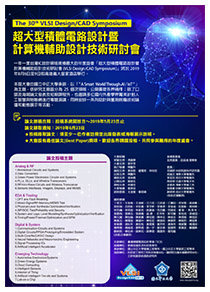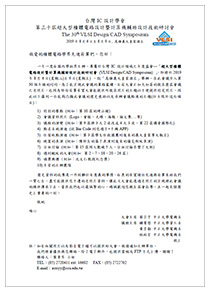Oral 5: Advanced Circuits and Signal Processing Systems for Biomedical Applications
Session Chair: Shin-Chi Lai (Nanhua University), Po-Yu Kuo (National Yunlin University of Science & Technology)Date: Aug. 7 (Wed.), 2019
Time: 15:30 – 17:00
Room: 6F 樂廳
| 順序 | 口頭報告論文 |
| 1 | 15:30 – 15:43 (SA21) A 10-Bits Low-Power SAR ADC for Biomedical Systems Chi-Chang Lu and Sheng-Yen Lai National Formosa University Abstract: A low-energy and area-efficient switching scheme is proposed to design a low-power successive approximation register analog-to-digital converter (SAR ADC). There are several reasons for the significant reduction in power consumption. First, in the first and second conversions, the switching energy of the capacitive digital-to-analog converter (CDAC) is zero because the voltage difference across the capacitor does not change. Moreover, in the third and subsequent conversions, only one switch changes its condition and the switching situation is changed from Vref to 1/2Vref or from 1/2Vref to ground. Compared with the conventional CDAC, the switching energy of the proposed CDAC is reduced by 97.66% and the total required capacitance is also reduced by 75%. The 10-bits low-power SAR ADC has been designed using TSMC 0.18um 1P6M technology. At a 1.2 V supply and the conversion rate of 100KS/s, when the input signal is 12.4KHz, the dynamic parameters SNDR and SFDR are 60.52dB and 67.34dB, respectively. The ENOB is 9.76 bits. The static parameter DNL is between -0.32LSB and 0.36LSB, and the INL is between -0.23LSB and 0.25LSB. |
| 2 | 15:43 – 15:56 (SA22) Multi-functional Cushion and Visual Feedback Rehabilitation Training System Po-Cheng Su, Ming-Ta Ke, Ya-Hsin Hsueh National Yunlin University of Science and Technology Abstract: In this study, we create a multi-function cushion and visual feedback rehabilitation training system. This system could give the warning to remind the user when the sitting posture is sloping or slipping down from the chair. In addition, we also design a computer game for raising users' interest in rehabilitation training. The system can be used in a battery-powered manner. Therefore, this system is not subject to power and will be easier to use. The purpose of the study is to help people to correct sitting posture to avoid unhealthy sitting posture and lead to spine tilt. With the appropriate game interface, users can carry out relevant training, increase their concentration during training and achieve better rehabilitation training. |
| 3 | 15:56 – 16:09 (SA23) Investigations on Impact of Sensing Characteristics for RuO2 Urea Biosensor Affected by Power Noise Po-Yu Kuo and Ze-Lin Lian National Yunlin University of Science & Technology Abstract: The urea biosensor was studied and developed for many years. Many researchers designed high performance urea biosensor using different sensing films. However, the characteristic of most reported biosensors was measured using simple instrumentation amplifiers. This simple measurement system does not consider the noise generated by power supply. The biosensor signal is generally operated under 1KHz and easily affected by the power line frequency component (60HZ). Therefore, this non-ideal effect can not be ignored. In this paper, the impact of power supply noise for ruthenium dioxide (RuO2) urea biosensor is analyzed. A new readout circuit is demonstrated, in the proposed circuit, a notch filter is applied to cancel the 60Hz power line noise. By applying the notch filter, the power line frequency component at 60HZ is suppressed. |
| 4 | 16:09 – 16:22 (SA24) A Prototype Design of EEG Sensing System with a Compact Sliding DFT Algorithm Shin-Chi Lai(1), S M Salahuddin Morsalin(1), Yu-Syuan Jhang(2), and Ming-Hwa Sheu(2) (1) Nanhua University and (2) National Yunlin University of Science and Technology Abstract: This paper presents an Electroencephalography (EEG) signal acquisition system design with incorporating the circuit design, and spectrum analysis. The data acquisition procedure consists four stages: 1) The acquisition of original EEG signal can be done by the active electrode and an instrumentation amplifier with a smaller gain; 2) Improves the signal quality by using band-pass filter and band-stop filter with IC OPAMP; 3) Those EEG signals were converted into the digital code through the analog-to-digital converter (ADC) that was integrated to a micro-controller; 4) a compact sliding discrete Fourier transform is applied to obtain the desired real-time spectrum information. The experimental results show that the system could implement the acquisition and storage of the EEG signals efficiently. |
| 5 | 16:22 – 16:35 (SA25) Analysis and Discussion of an Analog High-Order Low-Pass Filter Performance Evaluation Techniques Hsin-Wen Ting(1) and Chi-Yuan Chen(2) (1) National Kaohsiung University of Science and Technology and (2) ILI Technology Corporation Abstract: Analog filters are fundamental building blocks for biomedical application, and their functionalities are directly related to the requirements of acquisition of bioelectric signal and removal of noise. This paper analyzes and discusses a technique for evaluation of an analog high-order low-pass filter. The evaluation procedure is divided into three modes, first to estimate the passband characteristic, second, to estimate the stopband characteristic, and finally, to evaluate the performance of the analog filter by the analysis of the relationship between the attenuations at the passband and stopband. The technique is investigated to quantify the trade-offs between the evaluation accuracy and hardware cost, estimate the probability of having a specification-passed device, and estimate the evaluation time. The evaluated result is related to a “ratio” rather than a “specific value.” The experimental verification demonstrates the functionality, effectiveness, and feasibility of the technique. |
| 6 | 16:35 – 16:48 (SA26) A Voltage Compensation Embedded All Digital Temperature Sensors Jyun-Da Huang, Jhih-Yu Syu, and Po-Hui Yang National Yunlin University of Science and Technology Abstract: In this paper, a VDD variation compensated negative feedback compensation all-digital temperature sensing delay cell is proposed. This temperature sensing delay cell is designed in a differential loop for a ring oscillator, which quantifies the oscillation frequency with temperature changes. With digital temperature code, this temperature sensing system can be easily embedded in a digital system chip to provide absolute temperature monitoring of high-performance system chips. The circuit has verified in a 0.18μm CMOS process with a temperature range of 0°C to 100°C and a temperature resolution of 0.1°C. The voltage variation sensitivity of the supply voltage of 1.8V±10% is as low as 0.016MHz/ mV, compared to the traditional differential oscillator based temperature sensors, the voltage sensitivity improved by up to 90%. |
| 7 | 16:48 – 17:01 (S0163) Synthesis of Nondeterministic Behavior in Recombinase-Based Genetic Circuits Zi-Jun Lin, Wei-Chih Huang, and Jie-Hong Roland Jiang National Taiwan University Abstract: Recombinases have been exploited in synthetic biology as a technique to engineer genetic circuits for various application tasks. Prior works mostly studied the construction of combinational or sequential circuits with deterministic behavior. Nevertheless, nondeterminism is ubiquitous in biochemical systems and is an essential resource to enable various biochemical processes, such as cell differentiation and pattern formation. In this work, we study the synthesis of nondeterministic recombinase-based genetics circuits specified by a Boolean relation. We develop methods to create nondeterminism and synthesize the intended nondeterministic circuit. The synthesis methodology is experimented to evaluate the effectiveness of DNA sequence length reduction in the constructed genetic circuits. |
指導單位:
教育部資訊及科技教育司
主辦單位:
臺灣積體電路設計學會
承辦單位:
國立中正大學電機工程學系
國立中正大學資訊工程學系
協辦單位:
科技部工程司工程科技推展中心
國研院台灣半導體研究中心
中國電機工程學會
智慧聯網整合推動聯盟中心
中央研究院資訊科學研究所
贊助單位:
聯發科技股份有限公司
日月光半導體製造股份有限公司
威鋒電子股份有限公司
奇景光電股份有限公司
荷蘭商益華國際電腦科技(股)公司台灣分公司
台灣新思科技股份有限公司
財團法人工業技術研究院
瑞昱半導體股份有限公司
聯詠科技股份有限公司
鈦思科技股份有限公司
台灣是德科技股份有限公司
和澄科技股份有限公司
愛爾蘭商明導股份有限公司台灣分公司
一元素科技股份有限公司
力旺電子股份有限公司
博鑫醫電股份有限公司
群聯電子股份有限公司
晶心科技股份有限公司




